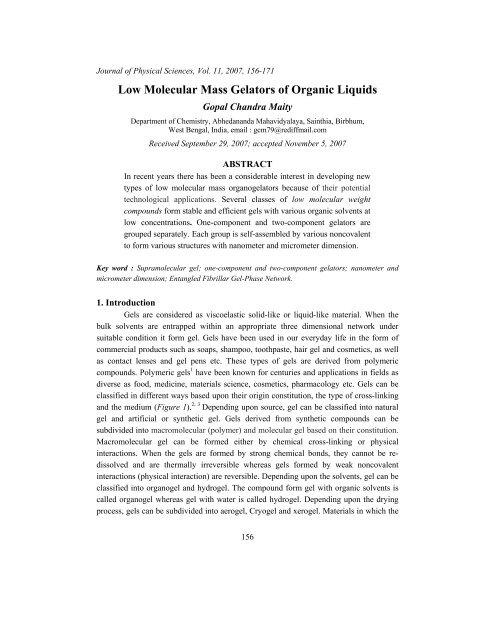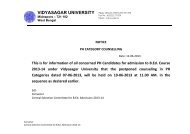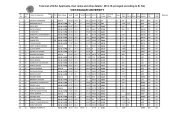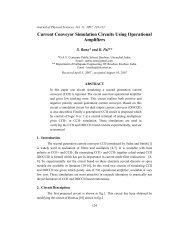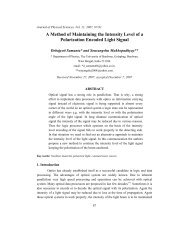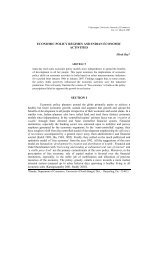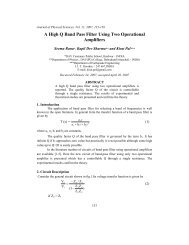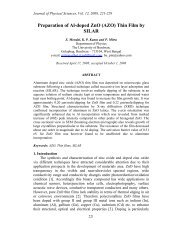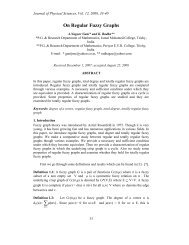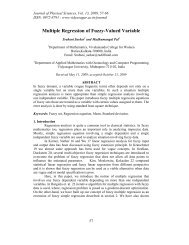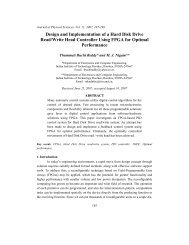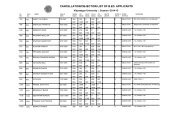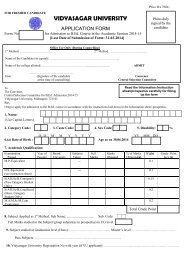Low Molecular Mass Gelators of Organic Liquids - Vidyasagar ...
Low Molecular Mass Gelators of Organic Liquids - Vidyasagar ...
Low Molecular Mass Gelators of Organic Liquids - Vidyasagar ...
You also want an ePaper? Increase the reach of your titles
YUMPU automatically turns print PDFs into web optimized ePapers that Google loves.
Journal <strong>of</strong> Physical Sciences, Vol. 11, 2007, 156-171<br />
<strong>Low</strong> <strong>Molecular</strong> <strong>Mass</strong> <strong>Gelators</strong> <strong>of</strong> <strong>Organic</strong> <strong>Liquids</strong><br />
Gopal Chandra Maity<br />
Department <strong>of</strong> Chemistry, Abhedananda Mahavidyalaya, Sainthia, Birbhum,<br />
West Bengal, India, email : gcm79@rediffmail.com<br />
Received September 29, 2007; accepted November 5, 2007<br />
ABSTRACT<br />
In recent years there has been a considerable interest in developing new<br />
types <strong>of</strong> low molecular mass organogelators because <strong>of</strong> their potential<br />
technological applications. Several classes <strong>of</strong> low molecular weight<br />
compounds form stable and efficient gels with various organic solvents at<br />
low concentrations. One-component and two-component gelators are<br />
grouped separately. Each group is self-assembled by various noncovalent<br />
to form various structures with nanometer and micrometer dimension.<br />
Key word : Supramolecular gel; one-component and two-component gelators; nanometer and<br />
micrometer dimension; Entangled Fibrillar Gel-Phase Network.<br />
1. Introduction<br />
Gels are considered as viscoelastic solid-like or liquid-like material. When the<br />
bulk solvents are entrapped within an appropriate three dimensional network under<br />
suitable condition it form gel. Gels have been used in our everyday life in the form <strong>of</strong><br />
commercial products such as soaps, shampoo, toothpaste, hair gel and cosmetics, as well<br />
as contact lenses and gel pens etc. These types <strong>of</strong> gels are derived from polymeric<br />
compounds. Polymeric gels 1 have been known for centuries and applications in fields as<br />
diverse as food, medicine, materials science, cosmetics, pharmacology etc. Gels can be<br />
classified in different ways based upon their origin constitution, the type <strong>of</strong> cross-linking<br />
and the medium (Figure 1). 2, 3 Depending upon source, gel can be classified into natural<br />
gel and artificial or synthetic gel. Gels derived from synthetic compounds can be<br />
subdivided into macromolecular (polymer) and molecular gel based on their constitution.<br />
Macromolecular gel can be formed either by chemical cross-linking or physical<br />
interactions. When the gels are formed by strong chemical bonds, they cannot be redissolved<br />
and are thermally irreversible whereas gels formed by weak noncovalent<br />
interactions (physical interaction) are reversible. Depending upon the solvents, gel can be<br />
classified into organogel and hydrogel. The compound form gel with organic solvents is<br />
called organogel whereas gel with water is called hydrogel. Depending upon the drying<br />
process, gels can be subdivided into aerogel, Cryogel and xerogel. Materials in which the<br />
156
<strong>Low</strong> molecular <strong>Mass</strong> <strong>Gelators</strong> <strong>of</strong> <strong>Organic</strong> <strong>Liquids</strong> 157<br />
typical pore structure and network are largely maintained when the pore liquid <strong>of</strong> a gel is<br />
replaced by air are called aerogels. However, it is not always clear to what extent the<br />
structure is maintained. Aerogels are highly porous solid materials with extremely low<br />
densities, open pores, and high specific surface areas. These result in interesting physical<br />
properties, such as extremely low thermal conductivity and low sound velocity, combined<br />
with high optical transparency. Cryogels are obtained when the pore liquid is removed by<br />
freeze drying. A xerogel is formed by conventional drying <strong>of</strong> the wet gels, that is, by<br />
increasing the temperature or decreasing the pressure with concomitant large shrinkage<br />
(and mostly destruction) <strong>of</strong> the initially uniform gel body. Shrinkage upon drying <strong>of</strong> a wet<br />
gel body is showed in Figure 2.<br />
Gels<br />
Source<br />
Medium<br />
Natural Artificial Organogel Hydrogel<br />
Constitution<br />
Supramolecular<br />
Macromolecular<br />
Cross linking<br />
Physical<br />
Chemical<br />
Figure 1. Classification <strong>of</strong> gels.<br />
(a)<br />
Aerogel<br />
Wet gel<br />
(b)<br />
Xerogel<br />
(c)<br />
Figure 2. Shrinkage upon drying <strong>of</strong> a wet gel body to give an aerogel (a) and xerogel (b, c)
158 Gopal Chandra Maity<br />
The organogels are in common with other gel systems that the gelling agent forms a<br />
continuous three- dimensional entangled network in the solvent, thereby preventing the<br />
flow <strong>of</strong> liquid. Gels derived from low molecular mass compounds are called<br />
supramolecular gel. Although, the formation <strong>of</strong> organogels from small organic molecules<br />
is an excellent example <strong>of</strong> supramolecular self-assembly process, most the organogelators<br />
have been found by serendipity rather than design and many aspects <strong>of</strong> organogels are<br />
still poorly understood. In recent year, low molecular mass gelators attracted<br />
considerable interest due to molecules <strong>of</strong> a great structural diversity. Their discovery and<br />
development are particularly important due to potential applications. <strong>Low</strong> molecular mass<br />
organogelators are self-assembled to form fibers, strands, tapes, helix via onedimensional<br />
growth <strong>of</strong> the molecules. The aggregation <strong>of</strong> gelator molecules is driven by<br />
multiple, weak interaction such as hydrogen bonding interaction, π- π stacking, 4 metal<br />
coordination, 9, 5, 6, 7 van der waals interaction. 8 A gel can be broken down into a primary,<br />
secondary, and tertiary structure like a protein to understand the mechanism <strong>of</strong> gel<br />
formation. 9 The primary structure (angstrom to nanometer scale) is determined by the<br />
molecular level recognition. As a result gelator molecules are aggregated in one<br />
dimension. The secondary structure (nano- to micrometer scale) is defined as the<br />
morphology <strong>of</strong> the aggregates like micelles, vesicles, fibers, ribbons or sheets. This<br />
secondary structure is directly influenced by the molecular structure. Finally the tertiary<br />
structure <strong>of</strong> a gel (micro- to millimeter scale) involves the interaction <strong>of</strong> individual<br />
aggregates and ultimately determines whether a gel is formed or instead, fibers (or other<br />
aggregates) precipitated from solution rather than trapped it. 10 The aggregation <strong>of</strong> gelator<br />
molecules occurred through the both branched fibers and entrangled fibers. The long,<br />
thin, flexible fibers are better able than shorter fibers to trap the solvent molecules,<br />
leading to gelation. 11<br />
The transition from molecular to primary and secondary structure has been<br />
explained by several methods. 12 As for example, Boden and co-workers have modeled<br />
the hierarchical self-assembly <strong>of</strong> rod-like chiral molecules, such as peptides in a β-strand<br />
conformation, into ribbons and fibers. 12a The transition from secondary to tertiary<br />
structure is determined by the type <strong>of</strong> interactions that can occur among the fibers.<br />
Gels derived from low molecular mass compound are usually prepared by heating<br />
the compounds in appropriate solvent and cooling the resulting saturated solution at room<br />
temperature. When the hot solution is cooled, the molecules start to condense and three<br />
situations are possible i.e a highly ordered aggregation giving rise to crystals, a random<br />
aggregation resulting in an amorphous precipitate and an aggregation process<br />
intermediate between these two gives rise to a gel (Figure 3).
<strong>Low</strong> molecular <strong>Mass</strong> <strong>Gelators</strong> <strong>of</strong> <strong>Organic</strong> <strong>Liquids</strong> 159<br />
Figure 3. Schematic representation <strong>of</strong> aggregation modes.<br />
2. Gelation Test<br />
The gelator is dissolved with appropriate amount <strong>of</strong> solvent (organic solvent or<br />
water) by warming in capped test tube or vial. By this procedure the solvent boiling point<br />
becomes higher than that under standard atmospheric pressure. Then the vial containing<br />
the solution is allowed to cool in air at room temperature, left for 2-3 h at this<br />
temperature. When a gel is formed, the homogeneous transparent substance did not flow<br />
when the vial is inverted (Figure 4). 13 The gel is denoted by “G”. The inverted vial<br />
approach 14 is used as a general criterion for gel formation.<br />
3. Gel Transition Temperature (T gel )<br />
The gel transition temperature is the required temperature below which flow <strong>of</strong><br />
the gel no longer is discernible over long periods. The gel transition temperature was<br />
determined by the ball dropped method. A glass ball was carefully placed on top <strong>of</strong> the<br />
gel and the temperature was slowly raised. The gel transition temperature was<br />
determined 15 as the temperature at which gel was unable to bear the glass ball and it<br />
dropped down. Gel transition temperature is denoted by ‘T gel ’. It is also fact that this type<br />
<strong>of</strong> measurement is highly influenced by surface tension and liquid density. To determine<br />
the thermal stability <strong>of</strong> the gels, T gel is plotted against the gelator concentrations. The gel<br />
transition temperature increases with increasing in the gelator concentration.
160 Gopal Chandra Maity<br />
a<br />
b<br />
Figure 4. Inverted vials containing colorless gel (a), colorful gel. (b).<br />
4. Morphology <strong>of</strong> Gels<br />
<strong>Molecular</strong> self-aggregation features can be observed by an electron microscope,<br />
since the initial stage <strong>of</strong> physical gelation is the self-assembly <strong>of</strong> gelator monomers. The<br />
morphology <strong>of</strong> the dried gels is studied by Scanning Electron Microscopy (SEM) or<br />
Transmission Electron Microscopy (TEM) analysis. The scanning electron microscopic<br />
studies <strong>of</strong> the gel is done using a thin slice <strong>of</strong> gel on microscopic slides and dried. Then<br />
the dried sample is coated by platinum or gold and observed under the SEM apparatus.<br />
The SEM images <strong>of</strong> dried gel indicates various structures like fibers network, tape,<br />
ribbon, rod, sheets, hole, micelles, vesicles, helix etc. with micro or nano dimension. The<br />
gel networks entrapped the solvent molecules and preventing the solvent molecules when<br />
the vial containing gels was inverted (Figure 4).<br />
5. One Component and two Component Organogelators<br />
In one-component system, a compound can be present in solution and forms gel<br />
with the solvents. Whereas in true two-component systems, an individual component can<br />
be present in isotropic solution, and only on additions <strong>of</strong> the second component will a gel<br />
actually form. In case <strong>of</strong> one-component, gelators molecules are stacked one after one to<br />
form gel networks by non covalent interactions such as π- π stacking, hydrogen bonding,<br />
van der waals interaction etc.. Whereas in the case <strong>of</strong> two-component gelators, one<br />
compound form a complex with another compound through donor-acceptor interaction,<br />
hydrogen bonding interaction etc.. Then the complexes are aggregated to form various<br />
structures like Fibrillar Gel-Phase Network, helix, ribbons, sheets etc.. One or twocomponent<br />
low molecular mass gelators are discussed separately.<br />
5.1. One-Component Organogelators<br />
5.1.1. Anthryl and anthraquinone derivatives<br />
Compound 2,3-Bis(n-decyloxy)anthracene(DDOA) 1 is a good organogelator at<br />
low concentration for a large number <strong>of</strong> solvents ranging from alkanes to alcohols, ethers,
<strong>Low</strong> molecular <strong>Mass</strong> <strong>Gelators</strong> <strong>of</strong> <strong>Organic</strong> <strong>Liquids</strong> 161<br />
ketones or halogenated molecules. 16,17 The molecules are self associated by dipolar force<br />
and van der waals interactions. 1 DDOA can also easily gelify various organic solvents<br />
including propylene carbonate (PC) at low concentrations by forming a three-dimensional<br />
network <strong>of</strong> fibers. 18 The electrochemical properties <strong>of</strong> organogel based on DDOA are<br />
reported. 19 The related anthraquinone (2) is also an efficient gelator <strong>of</strong> organic solvents. 20<br />
O<br />
O<br />
O<br />
1<br />
O<br />
O<br />
1a 2<br />
O<br />
Scheme 1. Anthryl derivative-based gelators.<br />
DDOA has recently been used to replicate non-functionalised silica fibres having<br />
double-scale porosity. 21 The organogelator DDOA has ability to grow organically<br />
modified hybrid silica fibres. 22 The modified derivative 2,3-dialkoxy phenazine gelate<br />
various organic solvents such as, methanol, ethanol, DMF, and acetonitrile. The gel in<br />
acetonitrile could be fine tuned by reversible protonation <strong>of</strong> the nitrogen on the gelator. A<br />
further increase in the concentration <strong>of</strong> acid, T gel value was decreased. The compounds<br />
2,3-didecyloxytetracene (DDOT) and 2,3-dihexadecycloxytetracene (DHDOT), which are<br />
the more efficient organogelator in various organic solvents like cyclohexane, DMSO,<br />
acetone, dichloromethane solvent due to enhance π-stacking ability <strong>of</strong> tetracenes. 23<br />
5.1.2 <strong>Gelators</strong> containing steroidal and condensed aromatic rings<br />
Another class <strong>of</strong> molecules (ALS) which are also efficient gelators <strong>of</strong> many<br />
organic solvents. These molecules consist <strong>of</strong> an aromatic group (A) connected to steroidal<br />
moiety (S) via a linking group (L). The organogelators based on cholesterol in which a<br />
chromophore unit is attached.<br />
5.1.2.1 Azobenzene steroid-based and crown ether steroid-based gelators<br />
A cholesterol derivative with an azobenzyl group is an organogelator with<br />
various organic solvents. 24,25 The trans form <strong>of</strong> the compound aggregates readily to form<br />
a gel and the cis form does not give the gelation properties. The irradiation <strong>of</strong> the butanol<br />
gel <strong>of</strong> the cis form <strong>of</strong> the compound transformed into trans form. Cholesterol-based<br />
gelator bearing a 4-pyridyl group was a very versatile gelator whereas cholesterol bearing<br />
3- or 2-pyridyl group gelled very few number <strong>of</strong> solvents. 26 Compound 3 and 4 shows the<br />
gelation properties in various organic solvents as well as the silanol compound TEOS
162 Gopal Chandra Maity<br />
(Scheme 2). 27 The SEM studies <strong>of</strong> the compound 4 showed a network <strong>of</strong> fibers structure<br />
with diameters ranging from 50 to 200 nm. The crown-appended cholesterol derivative<br />
act as an amphiphilic gelator for organic solvents. 28 Gel derived from azacrown<br />
derivative <strong>of</strong> cholesterol 5 (Scheme 2) in a mixture <strong>of</strong> methylcyclohexane and benzene<br />
solvent responded to added alkali metal or ammonium ions. 9 It is found that T gel increases<br />
with increase in the concentration <strong>of</strong> various alkali metal cations (such as Li + , Na + , K + ,<br />
Rb + and NH + 4 ). It is interesting to note that this increase was not continuous and after a<br />
saturation point reached, the T gel was decreased. Compounds 6, 7 and 8 which consist <strong>of</strong><br />
cholesterol moieties linked to azacrown capable <strong>of</strong> forming gels with various organic<br />
solvents.<br />
3. R – H<br />
4. R – NMe 3 + Br<br />
N<br />
N<br />
O<br />
O<br />
R =<br />
O<br />
O<br />
N<br />
N<br />
O<br />
O<br />
O<br />
O<br />
O<br />
O<br />
O<br />
O<br />
5<br />
O<br />
O<br />
O<br />
O<br />
O<br />
N<br />
R<br />
H<br />
N<br />
O<br />
O<br />
O<br />
O<br />
N<br />
R<br />
R<br />
N<br />
O<br />
O<br />
O<br />
O<br />
N<br />
R<br />
8<br />
6<br />
7<br />
Scheme 2: Cholesterol-based gelators containing crown ether and azobenzene moiety.
<strong>Low</strong> molecular <strong>Mass</strong> <strong>Gelators</strong> <strong>of</strong> <strong>Organic</strong> <strong>Liquids</strong> 163<br />
5.1.2.2 Anthryl and anthraquinone appended steroid-based gelators<br />
Cholesteryl 4-(2-anthryloxy) butyrate (CAB) could gelate a wide range <strong>of</strong><br />
solvents including alkanes, alkenes, alcohols, aldehyde, carboxylic acid esters, amines,<br />
and aromatic solvents. 29 Three-dimensional self-assembled fibrillar networks (SAFINs)<br />
was observed by the microscopy studies <strong>of</strong> CAB. The compound 10 gives gelation<br />
properties with organic solvents. The replacement <strong>of</strong> 2-anthryl part <strong>of</strong> compound 10 by<br />
phenanthryl, pyrenyl, or 9-anthryl did not give the gelation properties with organic<br />
solvents. Compound 11 is an efficient gelator whereas the replacement <strong>of</strong> R- group by<br />
NH group is not a successful gelator with organic solvents. 30 Steroid containing napthyl<br />
unit via a linking group (13) formed three-dimensional SAFINs through the gelation with<br />
various solvents like 1-propanal, 1-butanol, 1-pentanol, n-decane, n-hexanedecane,<br />
cyclohexane whereas compound 12 form three-dimensional SAFINs through gelation<br />
with organic solvents like ethanol, 1-propanal, 1-butanol, 1-pentanol, n-octanol, n-<br />
decane, n-hexanedecane, cyclohexane, benzyl alcohol, ethyl acetate. 31 The presence <strong>of</strong><br />
one extra double bond at C 5 position <strong>of</strong> steroid unit (12) compared with 13, changes the<br />
gelation properties. It is difficult to trace the specific reason(s) for these differences.<br />
O<br />
CAB 9<br />
O<br />
O<br />
O<br />
O<br />
10<br />
R<br />
O<br />
N<br />
O<br />
11 R = bulky group.<br />
NH<br />
O<br />
O<br />
12<br />
O<br />
NH<br />
O<br />
13<br />
O<br />
O<br />
O<br />
14<br />
Scheme 3: cholesterol containing chromophore unit based gelators.
164 Gopal Chandra Maity<br />
However, the range <strong>of</strong> liquids gelated by each suggests that the presence or<br />
absence <strong>of</strong> a double bond at C5 has some influence on the overall solubility <strong>of</strong> these<br />
LMOGs. Cholesterol containing azobenzene moiety linked via ester group (14) gelled<br />
with various organic solvents. 32<br />
Anthraquinone-steroid based gelators 15-19 gives the gelation properties with<br />
various organic solvents (Scheme 4). 39,33 The compounds 17, 19 were efficient gelator<br />
among the other compounds. The driving force for the aggregation <strong>of</strong> the gelator<br />
molecules was assigned by π- π stacking, van der waals interaction and other non<br />
covalent interactions. The gel transition temperature values <strong>of</strong> gel obtained from 15 and<br />
n-alkanes were considerably higher than those from 15 and alkan-1-ols. Various<br />
examples include both structurally complicated (ALS molecules with aromatic, linking,<br />
and steroidal groups) and simple LMOGs in a wide range <strong>of</strong> organic liquids were<br />
reported. 39<br />
AQ<br />
O<br />
O<br />
O<br />
15<br />
AQ<br />
O<br />
O<br />
O<br />
16<br />
O<br />
O<br />
AQ<br />
O<br />
17<br />
AQ<br />
O<br />
18<br />
O<br />
O<br />
AQ =<br />
AQ<br />
O<br />
19<br />
O<br />
Scheme 4: Anthraquinone-steroid based gelators.<br />
5.1.3 Gelator containing terpenoid and aromatic ring<br />
Compound 20 is able to gel with various alcoholic and mixed solvents. 34 Highly<br />
stable and efficient gels are obtained with aliphatic alcohols with
<strong>Low</strong> molecular <strong>Mass</strong> <strong>Gelators</strong> <strong>of</strong> <strong>Organic</strong> <strong>Liquids</strong> 165<br />
concentration (% w/v). It is also found that T gel increases with increase in the gelator<br />
concentration. The increase in T gel with increasing gelator concentration indicates that<br />
self-assembly is driven by strong intermolecular interactions.<br />
5.1.4 Sugar-based organogelators<br />
Methyl 4,6-O-benzylidene monosaccharide (Scheme 5) can act as strong<br />
organogelators for various organic solvents. 35 For the same concentration the sol-gel<br />
transition temperature (T gel ) <strong>of</strong> the compounds (Scheme 5) always appears in the order <strong>of</strong>:<br />
25 >23 >24 > 21 > 22. Methyl glycosides <strong>of</strong> 4,6-O-benzylidene derivative <strong>of</strong><br />
monosaccharides aggregate the solvent molecules through the formation <strong>of</strong> a hydrogenbonded-based<br />
gel network. The evidence <strong>of</strong> the hydrogen bond was given by FT-IR and<br />
temperature dependent NMR spectroscopy. Sugar-based gelators such as 27, 29, 31 and<br />
32 (Scheme 5) are capable <strong>of</strong> gelating various polar solvents. 36 Organogelators derived<br />
from different combinations <strong>of</strong> the gelators and solvent shows the fibrous or spherical<br />
morphology on SEM study. Due to the presence <strong>of</strong> amino groups, the transcription <strong>of</strong><br />
these organogel result in the formation <strong>of</strong> hollow fibrous or hollow spherical silica after<br />
calcinations. The transcription <strong>of</strong> the corresponding nitro analogues (26, 28, and 30) was<br />
not successful. Whereas the silica resulting from the ethanol gel <strong>of</strong> the amine-bearing α-<br />
glucose derivative 26 has a fibrous structure with a single, central channel, the silica<br />
obtained from the ethanol gel <strong>of</strong> amine-bearing β-glucose derivative 31 possesses several<br />
channels inside each silica fiber. The α-glucose-based gelator 32 could gelate a range <strong>of</strong><br />
organic solvents as well as water and can form fibers in two different ways. In organic<br />
solvents, the polar sugar parts can form a chain <strong>of</strong> intermolecular hydrogen bonds upon<br />
stacking and exposes the aromatic parts to the solvent. In water, the molecules are<br />
presumed to form fibers through π- π stacking, thus exposing the sugar parts to the<br />
solvent. 37 21<br />
22<br />
23
166 Gopal Chandra Maity<br />
24. R =H 25<br />
26. (α-glu): R = NO 2 28. (α-man): R = NO 2<br />
27. (α-glu): R = NH 2 29. (α-man): R = NH 2<br />
30. (β-glu): R = NO 2<br />
31. (β-glu): R = NH 2<br />
Scheme 5. Sugar-based gelators<br />
5.2 Two component organogelators<br />
5.2.1 Steroid-based gelators<br />
Aromatic donor substituted bile acid derivatives such as 33, 34 and 35 gives the<br />
gelation properties with various organic solvents in presence <strong>of</strong> electron deficient guest,<br />
32
<strong>Low</strong> molecular <strong>Mass</strong> <strong>Gelators</strong> <strong>of</strong> <strong>Organic</strong> <strong>Liquids</strong> 167<br />
trinitr<strong>of</strong>luorenone (TNF) as the accepter (Scheme 6). 38 The major driving force is donoracceptor<br />
interaction for the gelation. The stoichiometric requirement <strong>of</strong> the two<br />
components was established by measuring the T gel as a function <strong>of</strong> the ratio <strong>of</strong> 36:33 at a<br />
constant concentration <strong>of</strong> 33. The T gel values indicates that 1:1 stoichiometry are required<br />
for the effective gelation. The temperature dependence UV-VIS spectroscopy indicates<br />
the charge-transfer (CT) interaction between pyrene (donar) unit and trinitr<strong>of</strong>luorenone<br />
(acceptor). The gel formed from colorless 33 and 34 ( and pale yellow 36) are colored<br />
due to charge-transfer interaction. The intensity <strong>of</strong> this band changes substantially during<br />
the gelation. SEM images <strong>of</strong> the dried gel derived from 35/36 in n-octanol shows fibrous<br />
network.<br />
35<br />
33. X = NH<br />
Scheme 7. Two-component 34. X = -(Ester) organogelator based on cholic acid.<br />
36<br />
Scheme 6: Bile acid-based two-component gelators and TNF.<br />
Cholesteryl [(3,5-dinitrobenzoyl)oxy]acetate 37 and cholesteryl 3,5-Dinitrobenzoate 38<br />
(Scheme 7) gelify acetonitrile solvent in presence <strong>of</strong> polyaromatic hydrocarbons<br />
(PAHs). 39 The gel formation <strong>of</strong> rigid ester 38 is favored when the concentration is<br />
increased. In constrast gel formation <strong>of</strong> the less rigid ester 37 occurred at minimum<br />
concentration. SEM images <strong>of</strong> dried gel <strong>of</strong> compound 37 and anthracene in acetonitrile<br />
solution indicates the fibrous network.<br />
H<br />
O<br />
O O<br />
H H<br />
O<br />
37<br />
O 2<br />
N NO 2<br />
O 2<br />
N<br />
NO 2<br />
O<br />
O<br />
H<br />
H H<br />
38<br />
Scheme 7. Dinitrobenzoyl appended gelators.
168 Gopal Chandra Maity<br />
5.2.3 Terpenoid-based two-component gelator<br />
The anthylidene derivative 39 <strong>of</strong> arjunolic acid form thermo reversible gel with<br />
organic solvents in presence <strong>of</strong> electron deficent guest such as picric acid 40 or methyl-<br />
3,5-dinitrobenzoate. 40 The color change from yellow to deep red was observed during<br />
gelation. The temperature dependent UV-VIS spectroscopy indicates the charge transfer<br />
interaction between the anthylidene part <strong>of</strong> the triterpene derivative and picric acid. The<br />
significance <strong>of</strong> large aromatic surface as well as lypophilic triterpene backbone was<br />
discussed. To determine the stoichiometric requirement <strong>of</strong> the two components on<br />
gelation, gel transition temperature was measured with increasing concentration <strong>of</strong> picric<br />
acid at a constant concentration <strong>of</strong> anthylidene derivative. Scanning Electron<br />
Micrographs <strong>of</strong> gels reveal fibrous morphology.<br />
O OCH 3<br />
O 2<br />
N<br />
OH<br />
NO 2<br />
HO<br />
O<br />
O<br />
H<br />
39<br />
NO 2<br />
940<br />
Scheme 8. Terpenoid-based gelator and picric acid.<br />
5.2.4 Pyrene-based gelators<br />
The pyrene derivatives 41-46 (Scheme 9) formed gel with different organic<br />
solvents in presence <strong>of</strong> TNF due to tharge-transfer interaction between pyrine unit and<br />
trinitr<strong>of</strong>luorenone. 41 . The most <strong>of</strong> the gels were stable at room temperature for several<br />
days. Compounds 41 and 42 formed opque organogel with hydroxylic solvents whereas<br />
compound 43, 44, 45 and 46 formed transparent color gels in hydrocarbon hydroxylic<br />
solvents. The T gel value was maximum at 1:1 molar ratio <strong>of</strong> acceptor and donor. At a 1:1<br />
ratio <strong>of</strong> donor (42) to acceptor (36), the T gel values increased with increasing gelator<br />
concentration. The length <strong>of</strong> hydrocarbon chain did not affect the gelation ability and<br />
thermal stability <strong>of</strong> the gels. The temperature dependence UV-VIS spectroscopy and<br />
color change during gelation indicates the charge-transfer interaction between pyrene unit<br />
and TNF.
<strong>Low</strong> molecular <strong>Mass</strong> <strong>Gelators</strong> <strong>of</strong> <strong>Organic</strong> <strong>Liquids</strong> 169<br />
X<br />
n 41. X = COO , n = 15, 44. X = CH 2, n = 10<br />
42. X = COO, n = 7, 45. X = CH 2, n = 0<br />
43. X = CH 2 , n = 14, 46. X = O, n = 13<br />
Scheme 9. pyrene based gelators.<br />
6. Conclusions<br />
In this article, definition, classification, driving force and mechanism for the<br />
formation <strong>of</strong> gel and gel transition temperature has discussed. As an aid to defining<br />
strategies for the molecular design <strong>of</strong> new low molecular mass gelators, organogelators<br />
have been grouped separately. Each group <strong>of</strong> low molecular mass compound forms gel<br />
with various organic solvents. The first terpenoid-based one-component and twocomponent<br />
gelators are reported here. The study <strong>of</strong> supramolecular gel phase materials<br />
has led to a revolution in the ability <strong>of</strong> chemists to engineer nanoscale structures that have<br />
macroscopic s<strong>of</strong>t materials properties.<br />
REFERENCES<br />
1. (a) “Polymer Gels; fundamentals <strong>of</strong> Biomedical Application” D. Derossi, K. Kajiwara, Y.<br />
Osada, A. Yamauchi, Plenum Press, New York, 1991; (b)“Thermoreversible Gelation <strong>of</strong><br />
polymers and Biopolymers” J. M guenewt, Academic press, London(1992). (C) Corriu,<br />
R. J. P.; Leclercq. D. Angew Chem.. Int. Ed. Engl. 1996, 35, 1420,<br />
2. Osada, Y.; Kajiwara, K.; (ed.) Fushimi, T.; Hirasa, O.; Hirokawa, Y.; Matsunaga, T.;<br />
Snimomura, T.; wang, L. (assoc. ed.).; Ishida, H. Gels hand book. Vol. 1-3, Academic<br />
Press. San Diego. 2001.<br />
3. Sangeetha, N. M.; Maitra, U. Chem. Soc. Rev., 2005, 34, 821–836<br />
4. Tam, A. Y-Y.; Wong, K. M-C.; Wang, G.; Yam, V. W-W. Chem. Commun., 2007, 2028–<br />
2030<br />
5. (a) Terech. P.; Schaffhauser, V.; Maldivi, P.; Guenet J. M. Langmuir, 1992, 8, 2104. (b)<br />
Dammer, P.maldivi, P. Terech and J. Guenet, Langmuir, 1995, 11, 1500.<br />
6. (a) Yam, V. W.W. Chan, K. H. Y. ; Wong, K.M.C. and Zhu, N. Chem.Eur.J., 2005, 11,<br />
4535. (b) Yu, C.; Wong, K. M. C.; Chan, K.H.Y. and. Yam, V. W. W. Angew. Chem.,<br />
Int. Ed., 2005, 44, 791. (c) Yam, V.W.W.; Chan, K.H.Y.; Wong, K. M. C.; and Chu,<br />
B.W.K. Angew. Chem., Int. Ed., 2006, 45, 6169.
170 Gopal Chandra Maity<br />
7. (a) Kishimura, A.; Yamashita, T. and Aida, T. J. Am. Chem. Soc., 2005, 127,179. (b)<br />
Camerel, F.;.Bonardi, L; Schmutz, M.and Ziessel, R. J. Am. Chem. Soc., 2006, 128, 4548.<br />
(c) Weng, W., Beck, J. B., Jamieson, A.M.; Rowan, S.J. J. Am. Chem. Soc.,2006, 128,<br />
11663. (d) Camerel, F.; Ziessel, R.; Donnio, B.; Bourgogne, C.; Guillon, D.; Schmutz,<br />
M.; Iacovita, C. Bucher, J. P. Angew. Chem., Int. Ed., 2007, 46, 2659. (e) Naota, T.;<br />
Koori, H.; J. Am. Chem. Soc., 2005, 127, 9324.<br />
8. Sugiyasu, K.; Numata, M.; Fujita, N.; Park, S. M.; Yun, Y. J.; Kim, B. H.; Shinkai, S.<br />
Chem. Commun. 2004, 1996.<br />
9. Simmons, B. A.; Taylor, C. E.; Landis, F. A.; John, V. T.; McPherson, G. L.; Schwartz,<br />
D. K.; Moore, R. J. Am. Soc. 2001, 123, 2414.<br />
10. Estr<strong>of</strong>f, L. A.; Hamilton, A. D. Chemical Review, 2004, 104, 1201.<br />
11. Flory, P. J. Faraday Discuss. 1974, 57, 7.<br />
12. (a) Israelachvili, J. N.; Intermolecular and Surface Fources, 2 nd ed.; Academic Press: New<br />
York, 1991. (b) Schnur, J. M. Science 1993, 262, 1669. (c) Nandi, N.; Bagchi. B. J. Am.<br />
Chem. Soc. 1996, 118, 11208.<br />
13. (a) Hirst, A. R.; Smith, D. K. Chem. Eur. J. 2005, 11, 5496 – 550. (b) Beck, J. B.; Rowan,<br />
S. J. J. Am. Chem. Soc. 2003, 125, 13922-13923. (c) Kuroiwa, K.; Shibata, T.; Takada,<br />
A.; Nemoto, N.; Kimizuka, N. J. Am. Chem. Soc. 2004, 126, 2016-2021.<br />
14. Murata, K.; Aoki, M.; Suzuki, T.; Harada, T.; Kawabata, H.; Komori, T.; Ohseto, F.;<br />
Ueda, K.; Shinkai, S. J. Am. Chem. Soc. 1994, 116, 6664-6676.<br />
15. Takahashi, A.; Sakai, M.; Kato, T. Polymer. J. 1980, 12, 335-341.<br />
16. Brotin, T.; Utermohlen, R.; Fages, F.; Bouas-Laurent, H.; Desvergne, J. P. Chem.<br />
Commun. 1991, 416.<br />
17. Terech, P.; Bouas-Laurent, H.; Desvergne, J. P. J. Colloid Sci. 1995, 174, 258.<br />
18. Placin, F.; Desvergne, J.-P.; Lassegues, J.-C. Chem. Mater. 2001, 13, 117.<br />
19. Placin. F.; Desvergne, J.-P.; Belin, C.; Buffeteau, T.; Desbat, B.; Ducasse, L.; Lassegues,<br />
J.-C. Langmuir 2003, 19, 4563.<br />
20. Terech, P.; Weiss, R. G.; Chemical Review, 1997, 97, 3133.<br />
21. Clavier, G.M.; Pozzo, J. L.; Bouas-Laurent, H.; Liere, C.; Roux , C.; Sanchez, C. J.<br />
Mater. Chem. 2000, 10, 1725.<br />
22. LIusar, M.; Roux, C.; Pozzo, J. L.; Sanchez, C., J. Mater. Chem., 2003, 13, 442-444.<br />
23. Reichwagen, J.; Hopf, H.; Guerzo, A. D.; Belin, C.; Bouas-Laurent, H.; Desvergne, J.-P.<br />
Org. Lett., 2005, 7, 6<br />
24. Murata, K.; Aoki, M.; Nishi, T.; Ikeda, A. and S. Shinkai. J. Chem. Soc., Chem. Commun.<br />
1991, 1715.<br />
25. Murata, K.; Aoki, M.; Suzuki, T.; Harada, T.; Kawabata, H.; Komri, T.; Olrseto, F.;<br />
Ueda, K.; Shinkai, S. J. Am. Chem. Soc. 1994, 116, 6664-6676.<br />
26. Kawano, S-i.; Fujita, N.; Bommel, K. J. C.; Shinkai, S. Chemistry Letter, 2003, 32, 12.<br />
27. For a review on the gelation <strong>of</strong> liquids by cholesterol derivatives, (a) Shinkai, S.; Murata,<br />
K.; J. Mater. Chem. 1998, 8, 485-495. (b) The aggregation structure <strong>of</strong> these gels has
<strong>Low</strong> molecular <strong>Mass</strong> <strong>Gelators</strong> <strong>of</strong> <strong>Organic</strong> <strong>Liquids</strong> 171<br />
been studies by using small angle X-ray scattering: Sakurai, K.; One, Y.; Jung, J. H.;<br />
Okamoto, S.; Sakurai, S.; Shinkai, S. J. Chem. Soc. Perkin Trans. 2 2001, 108-112.<br />
28. Jung, J. H.; Kobayashi, H.; Masuda, Shimizu, T.; Shinkai, S. J. Am. Chem. Soc. 2001,<br />
123, 8785.<br />
29. Lin, Y.-C.; B. Kachar and. Weiss, R. G J. Am. Chem. Soc., 1989, 111, 5542.<br />
30. .(a) Lu, L.; Cocker, T. M.; Bachman, R. E.; Weiss, R. G. Langmuir, 2000, 16, 20-34. (b)<br />
Lu, L Ph.D. Thesis, Georgetown University, Washington, DC, 1997.<br />
31. George, M.; Weiss, R. G. Accounts <strong>of</strong> Chemical Research, 2006, 39, 489.<br />
32. (a) Mukkamala, R.; Weiss, R. G. J. Chem. Soc., Chem. Commun., 1995, 375-376. (b)<br />
Wang, R.; Geiger, C.; Chen, L.; Swanson, B.; Whitten, D. G. J. Am. Chem. Soc. 2000,<br />
122, 2399-2400.<br />
33. Mukkamala, R.; Weis, R. G. Chem. Commun. 1995, 375.<br />
34. (a) Bag, B. G.; Maity, G. C.; Pramanik, S. R. Supramol. Chem. 2005, 17, 383. (b) Bag, B.<br />
G.; Maity, G. C.; Pramanik, S. R. Pramana, 2005, 65<br />
35. (a) Gronwald, A.; Shinkai, S. Chem. Eur. J. 2001, 7, 20. (b) Yoza, K.; Amanokura,b N.;<br />
Ono, Y.; Akao, T.; Shinmori, H.; Takeuchi, M.; Shinkai, S. Reinhoudt, D. N. Chem. Eur.<br />
J. 1999, 5, 2722 - 2729; (c) Luboradzki, R.; Gronwald, O. Ikeda, M.; Shinkai, S.;<br />
Reinhoudt, D. N. Tetrahedron 2000, 56, 8697 -8701;(d) Gronwald, O.; Sakurai, K.;<br />
Luboradzki, R.; Kimura, T.; Shinkai, S. Carbohydr. Res. 2001, 331, 307-318.<br />
36. (a) Jung, J. H.; Amaike, M.; Shinkai, S. Chem. Commun. 2000, 2343-2344. (b) Jung, J.<br />
H.; Amaike, M.; Nakashima, K.; Shinkai, S. J. Chem. Soc. Perkin Trans. 2 2001, 1938-<br />
1943. (c) Jung, J. H.; Amaike, M.; Shinkai, S. Trans. Mater. Res. Soc. Jap. 2001, 26, 527-<br />
530.<br />
37. Gronwald, O.; Shinkai, S. J. Chem. Soc. Perkin Trans. 2 2001, 19933-1937.<br />
38. Mitra, U.; Vijay Kumar, P.; Chandra, N.; D`Souza, L. J.; Prasanna, M. D.; Raju, A. R.<br />
Chem. Commun. 1999, 595.<br />
39. Rizkov, D.; Gun, J.; Lev, O.; Sicsic, R.; Melman, A. Langmuir, 2005, 21, 12130-12138.<br />
40. “Donar-Acceptor Interaction Promoted Gelation: Visual Observation <strong>of</strong> Color Change”,<br />
Bag, B. G.; Maity, G. C.; Dinda, S. <strong>Organic</strong> Lett. 2006, 8, 5457.<br />
41. Bablu, P.; Sengeetha, N. M.; Vijaykumar, P.; Mitra, U.; Rissanen, K.; Raju, A. R. Chem.<br />
Eur. J. 2003, 9, 1922-1932.


